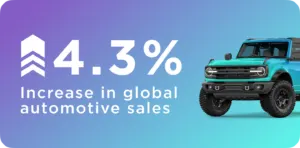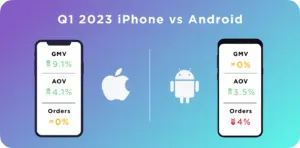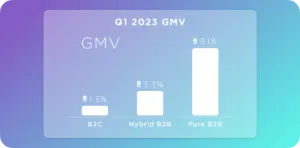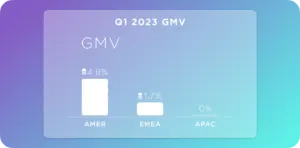2023 Global Ecommerce Report: Automotive


2023 Global Ecommerce Report: Automotive
Get The Print Version
Tired of scrolling? Download a PDF version for easier offline reading and sharing with coworkers.
A link to download the PDF will arrive in your inbox shortly.
Today, there are few things you can’t buy online. Furniture, cell phones, wedding rings and even groceries can be purchased at the click of a button — but one of the most unexpected breakthroughs into ecommerce has been the automotive industry.
Of course, many consumers still prefer to purchase cars and auto parts in-store rather than online, and this trend is unlikely to change anytime soon. However, with the impact of COVID-19 and the rise of third-party vehicle marketplaces, it’s no surprise the automotive industry is shifting gears to ecommerce.
From family-owned businesses such as BB Wheels to big-name brands such as BMW and MINI, BigCommerce has seen a number of our auto merchants picking up speed online.
According to an analysis by eMarketer, U.S. auto and parts retail ecommerce sales are projected to reach $182.48 billion by 2026, and Fortune Business Insights predicts that the global automotive ecommerce market will hit $213.08 billion by 2029.
While the U.S. auto market only accounts for 6.8% of all U.S. retail ecommerce sales, eMarketer predicts that this category will have the third largest compound annual growth rate between 2023 and 2027 (among other categories such as apparel and accessories, food and beverage and health and personal care).
If the trends of Q1 remain constant or improve, our data also shows that the automotive category is poised for growth in 2023. Read on for more insights from BigCommerce and our merchants about how the automotive industry is shifting gears online this year.
Methodology
BigCommerce’s automotive data is sourced directly from our merchants and was pulled on May 16, 2023. All data is global and pertains to all countries where BigCommerce merchants do business, unless otherwise noted.
All comparisons are congruent comparisons between the same number of existing stores dating back to the earliest period used in the comparison. For example, a comparison between Q1 2022 and Q1 2023 would use data only from BigCommerce stores that existed in Q1 2022, unless otherwise noted.
How the Automotive Industry Performed in Q1 2023

In Q1 2023, we saw a 4.3% increase in gross merchandise volume (GMV) for automotive merchants compared to Q1 2022. Similar growth held true for automotive’s average order value (AOV), which saw a 5% increase between Q1 2022 and Q1 2023.
However, year-over-year (YoY) orders for the automotive category did not follow this same pattern, with orders remaining relatively flat from 2022 to 2023.
Mobile sales experienced slight increase.

It should come as no surprise that most ecommerce categories are making the shift to mobile commerce. In fact, eMarketer expects mobile sales to account for 43.4% of total ecommerce sales in 2023 — up from 41.8% in 2022.
But despite this mass shift toward m-commerce, our data revealed only a slight increase in mobile sales for the automotive category. Comparing Q1 2022 to Q1 2023, automotive merchants experienced a 5% increase in GMV, zero change in orders and a 4.1% increase in AOV.
When comparing order sources, however, online sales via iPhone slightly outperformed sales via Android.
Between Q1 2022 and Q1 2023, the automotive category saw a 9.1% increase in GMV, a 4.1% increase in AOV and a 4.8% increase in orders via iPhone. However, by the same measure, the automotive industry saw a 3.5% increase in AOV, zero change for GMV and a 4% decrease in orders via Android.
Automotive merchants pick up speed with B2B.

When it comes to pure B2B selling, the automotive industry is showing notable YoY improvement. Automotive GMV was up 9.1% from Q1 2022, AOV was up 8.7%, while orders remained relatively flat.
Hybrid B2B (merchants selling both B2C and B2B) numbers also showed some improvement. Automotive GMV was up 3.3% and AOV was up 7%, while orders were down 3.4%.
B2C selling, on the other hand, did not show the same growth. Automotive merchants experienced only a 1.3% increase in GMV and a 2.2% increase in AOV YoY, while number of orders remained flat.
Automotive sees growth in AMER and EMEA.

While not quite up to par with overall ecommerce performance, the automotive category did experience slight growth in North America, with a 4.8% increase in YoY GMV and 5.2% increase in AOV. However, the number of orders remained flat.
In EMEA, automotive merchants saw a 1.7% increase in GMV between Q1 2022 and Q1 2023, as well as a 5.1% increase in AOV, while orders decreased by 3.3%. In APAC, however, automotive GMV, orders and AOV all remained relatively flat.
Automotive Ecommerce Trends and Predictions
The numbers don’t lie: automotive merchants are revving up their ecommerce strategies and show no signs of slowing. But as a newer retail category in the ecommerce space, the automotive industry has found some unique ways to excel online.
Here are some notable ecommerce trends we found that are shaping the automotive category in 2023:
Digital showrooms bring the dealership experience online.
While many dealers are expecting to see an increase in online sales through 2030, for now, in-person dealerships are here to stay. In fact, a report by PwC showed that roughly 80% of car customers still prefer to shop in-person — with the top reasons being to test drive cars (89%), to complete deals face-to-face with a salesperson (82%) and to experience the car in-person before buying (79%).
Purchasing any item online (especially a high-ticket item) is already risky enough, but purchasing a car without experiencing it in-person adds a new level of uncertainty — which is why many automotive merchants have adopted a new way of selling online: digital showrooms.
With the help of new technologies, automotive brands are able to create an immersive ecommerce experience that mimics that of a dealership. Digital showrooms not only enable users to customize the features, trim and model of their car, but also perform virtual test drives and demos. This way, customers can accurately visualize their dream car without ever stepping foot in a dealership.
One BigCommerce merchant that’s bringing the showroom online is BB Wheels — a retailer of wheels, tires and vehicle accessories. Using their interactive Vehicle Visualizer, customers can easily visualize how a specific wheel will look on a particular vehicle.
All the user has to do is select their vehicle year, make and model, and BB Wheels will provide a wide selection of compatible wheels, tires and accessories to shop from. Thus, customers can stop guessing and start visualizing their dream car before hitting the “Buy” button.
Digital advertising helps drive revenue.
“Meet your customers where they are.”
It’s a well-known phrase in the ecommerce world, and for good reason. Rather than putting in the work to find your website, customers want your website to be brought to them. With the help of digital advertising, automotive retailers can engage with their customers across various stages of the buyer journey, simplify the sales process and ultimately convert more leads into sales.
While it’s still common to see automotive billboards and television ads, an increasing number of auto retailers are turning to social channels like Facebook, Google and Instagram to engage with customers and showcase new products. Not only can this increase brand awareness, but it also allows auto retailers to collect first-party data in order to better tailor the advertising experience for the customer.
Van Cafe, a manufacturer and retailer of Vanagon parts, found its own success with digital advertising. Turning to Google Ads, the company was able to drive traffic, target more customers and automate features. And since Google Ads is native on the BigCommerce platform, the integration was free and easy to set up.
In addition, Van Cafe needed to target a niche van-life audience, so they utilized Performance Max for Google Ads.
“We went from ads all over the place to very detailed, pinpointed targeting, thanks to Google’s AI. It’s allowed us to dial in on those specific products that we know will sell well with minimal touch points. We saw an uptick in site visits and conversions because of that,” said Ingrid Getzan, Van Cafe’s former Director of Marketing.
Convenient payment options to streamline the experience.
According to a survey of dealers by PwC, the top three sources of customer dissatisfaction are price negotiations (49%), negotiating financing (46%) and document signing (41%). In addition, 66% of car dealers agreed that customers expect purchasing information in digital form, particularly regarding financing options.
Needless to say, purchasing has been a major pain point for car shoppers, leading both online and traditional dealers to think outside the box when it comes to payment options. Mobile wallets, payment scheduling and contactless transactions are just a few of the payment solutions changing the game in auto retail today.
In its search for a new ecommerce platform, Brock’s Performance — a manufacturer and seller of name-brand motorcycle parts — knew it needed payment options to give shoppers the flexibility to pay when and how they want.
“At the top of our list, we were looking for a payment experience where customers could get in and out seamlessly,” explained Brock’s Performance Vice President Jeff Grieco.
Thus, the company now offers multiple payment options, including PayPal, Google Pay and Buy Now, Pay Later (BNPL).
Vehicle marketplaces rev up online sales.
An automotive brand looking to push into online marketplaces doesn’t need to begin from ground zero. By integrating with third-party marketplaces such as Amazon, O’Reilly Auto Parts, Walmart and even eBay, automotive companies can take advantage of a customer base on platforms already proven to succeed.
Some of these marketplaces — such as CarMax and Carvana — primarily sell used cars, while others — like CarSaver at Walmart — sell new and used cars through a network of dealers. With the rising demand from online car buyers, these third-party vehicle marketplaces have positioned themselves to fill the gap left by traditional dealers.
According to Fortune Business Insights, “The availability of a broad range of automobiles and auto parts online, lower cost than traditional retail, 24×7 access, and price transparency will considerably drive the growth of this industry.”
Navigating the Future of Automotive Ecommerce
While the automotive industry has already undergone a major transformation, the future holds even more potential. From data analytics to online subscription services, the future of automotive ecommerce is coming in full speed.
Omnichannel selling creates a connected user experience.
While many automotive customers are moving online, there remains a clear need for the in-dealership experience — which doesn’t seem to be disappearing anytime soon. Thus, automotive retailers will need to implement a holistic omnichannel strategy, one that weaves together all business channels, both online and offline, to create a consistent and engaging customer experience.
According to a report by Deloitte, providing a strong omnichannel strategy requires that auto retailers focus on several key areas:
Customer engagement during the research phase: Use target advertising and messaging to guide potential customers to the next stage in their buying journey.
Cross-channel customer touchpoint management: Ensure all touchpoints — online and offline — work together to create a seamless experience.
Transactional efficiency: Streamline the checkout process with flexible payment and financing options.
Continued engagement throughout the customer lifecycle: Continue the post-sales experience with personalized communications, services and support.
Data analytics provide customer insights.
These days, it’s never been easier for online retailers to leverage the power of data to gain customer insights, measure performance and optimize inventory — and auto dealers are already in on the action.
Particularly for dealers selling both online and offline, data analytics can be a powerful tool for improving inventory management by reducing overstocking or understocking. With the ability to analyze customer trends and forecast demand, dealers can accurately adjust their pricing strategies, product offering and inventory levels.
Additionally, big data and predictive analytics can provide insight into customer behavior, such as how long a customer spends on a page, what they’re browsing and what products they’re adding to their carts. As a result, auto retailers can make data-informed decisions about how to structure their website, what products to offer and how to market them accordingly.
Subscription services disrupt car ownership.
Today, nearly all ecommerce industries offer some sort of subscription service. Top retailers across food and beverage, electronics, fashion and apparel and health and beauty are leveraging subscription business models — and now automotive is hopping on the bandwagon.
According to the same survey by PwC, roughly 4 in 10 consumers say they would consider using a car subscription service for their next vehicle, and 71% of dealers claim that subscription services are a “viable business model for their franchisees.”
Rather than being locked into a long-term contract, car buyers can now pay a monthly fee to swap out their car each month and get access to specific car models, insurance and maintenance services. Not only do subscription business models provide a flexible alternative for the customer, but they also help create new revenue streams for the dealer.
The Final Word
Looking back on Q1 2023, it’s clear that the automotive industry is on a roll when it comes to ecommerce. Despite a year of economic uncertainty, the auto category is taking well to many of the trends sweeping ecommerce retail, particularly in the B2B space.
While it may be a newer player in the online arena, the automotive industry is quickly shifting gears to ecommerce, leveraging new strategies such as digital advertising, virtual showrooms, flexible payment options and online vehicle marketplaces. And in the future, omnichannel selling, data analytics and subscription services seem poised to become the next big auto trends.
Be on the lookout for our next 2023 Ecommerce Report, where we’ll explore even more shopping verticals and how online merchants can stay ahead of the curve.

Haylee is a Content Marketing Writer at BigCommerce, where she partners with the SEO team to craft narratives and blog content. She earned a B.A. in English Literature from the University of Texas at Austin and afterward spent a year abroad to pursue a Master's in International Management from Trinity College Dublin. When she’s not writing, you can usually find Haylee with her nose in a book, enjoying live music or scoping out the best local coffee shops.